English daisy with its delicate petals and cheerful demeanor, has captured the hearts of gardeners for generations. Whether adorning cottage gardens, bordering pathways, or gracing floral arrangements, English daisies bring a touch of whimsy and nostalgia to any landscape.
Before we delve into the intricacies of cultivation, let’s get acquainted with the English daisy (Bellis perennis). The English Daisy, scientifically known as Bellis perennis , Originated from Europe and parts of Asia, this perennial herbaceous plant belongs to the Asteraceae family. Its botanical name, “Bellis,” is derived from the Latin word for “pretty,” which aptly describes the charm of its dainty blooms.
Its compact rosettes of spoon-shaped leaves form a verdant carpet upon which its whimsical blooms emerge. Each flower boasts a golden-yellow center, surrounded by numerous slender petals in white, pink, or red shades. These charming blooms sit atop wiry stems, nodding gently in the breeze like a host of miniature suns. English daisies are low-growing plants, usually reaching a height of 6 to 12 inches (15 to 30 cm).
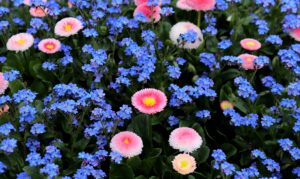
Sunlight Requirement
English daisies prefer full sun to partial shade. They thrive best in areas that receive at least 4 to 6 hours of direct sunlight daily. In hotter climates, providing some afternoon shade can help protect the plants from excessive heat and prolong the blooming period.
Soil Requirements
They grow well in well-drained soil that is rich in organic matter. The ideal soil pH is slightly acidic to neutral (pH 6.0 to 7.0). Amend heavy clay or poor-quality soil with compost or well-rotted manure to improve drainage and fertility.
Temperature and Humidity
English daisies prefer cool to mild temperatures. They can tolerate light frost but may struggle in very hot or humid climates. They are hardy in USDA zones 4-8, making them suitable for various garden settings.
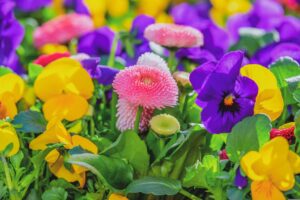
Propagation and Plantation of English Daisy
English daisies are relatively easy to propagate and plant, making them a gardener’s favorite.
Sowing Seed Indoors
Start seeds indoors 6-8 weeks before the last expected frost.
Use seed trays or small pots filled with a seed-starting mix.
Sow seeds on the surface of the soil and lightly press them in. Do not cover them with soil, as they need light to germinate.
Keep the soil consistently moist but not waterlogged.
Place the trays or pots in a bright location with indirect sunlight or under grow lights.
Seeds should germinate in about 14-21 days.
Once seedlings have two true leaves, they can be transplanted into individual pots.
Sowing Seed Outdoors
Direct sow seeds in the garden after the danger of frost has passed.
Prepare the soil by loosening it and removing any weeds or debris.
Scatter seeds on the soil surface and lightly press them in, ensuring good seed-to-soil contact.
Keep the soil moist until seedlings emerge.
Space plants about 6-12 inches (15-30 cm) apart to allow for adequate air circulation and room for growth.
Propagation By Division
Divide established plants in early spring or fall.
Carefully dig up the entire plant, ensuring you get a good portion of the root system.
Gently separate the plant into smaller sections, making sure each section has roots and some foliage.
Replant the divisions immediately in prepared soil, spacing them appropriately.
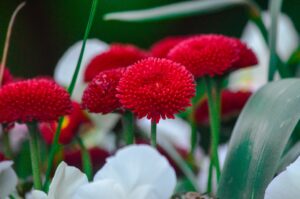
Watering Requirements of English Daisy
Keep the soil consistently moist, especially during the growing season. However, avoid overwatering, as English daisies do not like soggy conditions. Water the plants at the base to prevent water from sitting on the leaves and flowers, which can lead to disease.
Fertilization of English Daisy
Feed English daisies with a balanced, slow-release fertilizer in early spring to promote healthy growth and abundant blooms. Avoid excessive nitrogen, as it can lead to lush foliage at the expense of flowers.
Deadheading English Daisy Flower
To encourage continuous blooming and maintain a tidy appearance, deadhead spent flowers regularly throughout the growing season. Simply pinch off the faded blooms at their base to prevent seed formation and stimulate the production of new flowers. In late summer or early fall, you can also cut back the foliage to encourage fresh growth and prolong the flowering period.
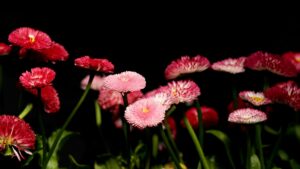
Pests and Diseases
English daisies are relatively resistant to pests and diseases, but they may occasionally encounter issues such as aphids, powdery mildew, or crown rot. Monitor your plants regularly for signs of pests or diseases, and take prompt action to address any problems that arise. Insecticidal soap or neem oil can help control aphids, while a fungicide may be necessary to treat powdery mildew. Ensure good air circulation around the plants to prevent fungal infections, and avoid overhead watering, which can promote disease spread.
Some Interesting Uses in the Garden
Ground Cover: English daisies make an excellent ground cover due to their low-growing habit and dense foliage.
Borders and Edging: They are perfect for edging flower beds, borders, and pathways, adding a splash of color and texture.
Containers: English daisies also do well in containers, making them versatile for patio gardens and small spaces.
Lawns: In some regions, English daisies are used to create flowering lawns, providing a charming, naturalistic look.
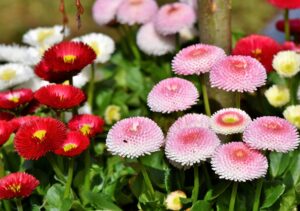
Varieties of English Daisies
English daisies are available in a variety of cultivars, offering a range of flower colors, sizes, and forms to suit every taste and garden style. Some popular varieties include:
‘Pomponette’: This cultivar features double flowers in shades of pink, red, or white, creating a charming pom-pom effect.
‘Rob Roy’: With its vibrant red flowers and compact growth habit, ‘Rob Roy’ adds a bold splash of color to the garden.
‘Galaxy’: Known for its large, single flowers with contrasting centers, ‘Galaxy’ comes in shades of pink, rose, or white.
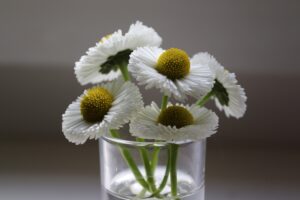
As we conclude our journey through the enchanting world of English daisies, we are reminded of the simple joys and timeless beauty they bring to our gardens. With their cheerful blooms and easy-going nature, these delightful flowers have earned a cherished place in the hearts of gardeners around the world. So, whether you’re planting them in a cottage garden, a sunny border, or a whimsical container arrangement, embrace the charm of English daisies and let your garden bloom with everlasting grace and elegance.


